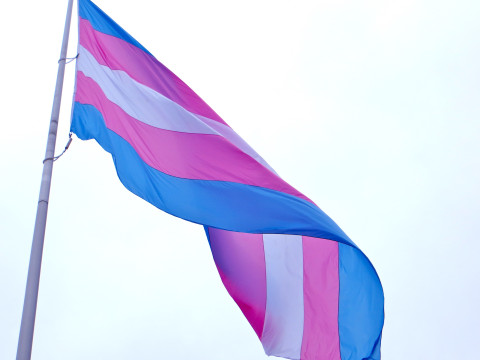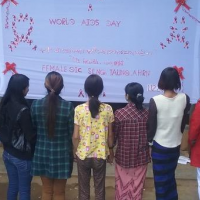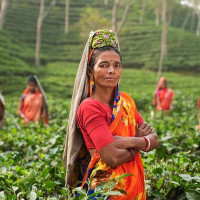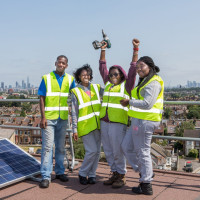Rethinking gender justice Lessons from the transgender and HIV movement
Temas
Regiones
A Commentary by DPAG and TNI
Gender norms affect everyone: people of all genders and ages, people in urban and rural areas, people with high-paying and low-paying jobs, people who use or do not use drugs, as well as people living with health statuses of all kinds. Paired with one’s socioeconomic backgrounds, gender norms and inequalities come in different shapes and sizes, and so do visions of gender justice.
As part of our exciting journey exploring the endless multitude of gender just visions, we spoke with Sakura (30) and Noe Noe (26), two transgender1 women working as peer educators and advocates at the Myanmar MSM and Transgender Network (MMTN), an organisation specialised in HIV prevention and care related activities in various parts of Myanmar.
Our conversation with Sakura and Noe Noe shows that there is so much that the HIV movement – particularly that involving transgender women – can teach us about gender justice.

Torbakhopper, CC BY-SA 3.0 <https://creativecommons.org/licenses/by-sa/3.0>, via Wikimedia Commons
HIV care for transgender communities in Myanmar: Slow and uneven
There are approximately 270,000 people living with HIV in Myanmar, according to 2021 data. The number of new HIV infections in Myanmar has decreased each year, from almost 30,000 in the early 2000s to around 11,000 in 2017. Myanmar has also performed reasonably well when it comes to providing treatment access for people living with HIV, and is facilitating viral suppression for 95 percent of those on treatment. Programmes involving PrEP (pre-exposure prophylaxis), a prescription medicine that can reduce one’s chance of becoming infected with HIV, are available since its inclusion in Myanmar’s National Strategic Plan IV 2020-2025.
However, both the COVID-19 pandemic and the political crisis that erupted in 2021 have undermined HIV related programmes, along with the wider healthcare system on which such programmes rely in Myanmar. Stigma and criminalisation continue, in particular related to sexuality, gender expressions, and drug use, weakening any attempt to curb HIV-related morbidity and mortality. This disproportionately harms marginalised communities such as sex workers, people who use drugs, men who have sex with men (MSM)2, and transgender people already suffering from socioeconomic exclusion or exploitation.
In the context of HIV response and related data in Myanmar, transgender women have typically been categorised in the MSM population, even though many of them do not identify as men. Meanwhile, as underlined by Sakura, HIV prevention and care services (including the PrEP programme) in Myanmar were initially targeted only towards the so-called MSM community, and “only a couple of years back the PrEP programme was widened for the transgender community,” added Sakura.
“Transgender people often face discrimination not only due to their gender [expressions], but also because society tends to associate them with HIV spread and infection,” explains Sakura as she describes her HIV prevention work in six townships across Yangon, as well as parts of Rakhine and Mon State. Indeed, a 2021 report by the UNFPA shows that transgender women are more likely to experience violence and discrimination compared to others who do not identify as heterosexual or cisgender3 (such as – but not limited to – people identifying as lesbian, gay, bisexual, transgender, and queer4, or LGBTQ+5), who are already highly vulnerable to stigma and abuse, including in medical settings.
“Prior to Covid, there seemed to be more teasing and stigma targeting the transgender community, but now transgender people seem to have more freedom and mobility,” added Sakura as she talked about the growing visibility of transgender and other LGBTQ+ people, including in social movements across Myanmar.
“Societal perspective has been slowly changing for the better, because there have been more social media and online campaigns against discrimination, for instance in the form of videos. These online campaigns are more attractive nowadays, and social influencers – like famous make-up artists – are involved in talking about topics that are considered taboo such as sexual and reproductive health and rights (SRHR), PrEP, et cetera,” explained Sakura, sounding optimistic about the post-Covid changing attitudes towards transgender people.
Nevertheless, many people still do not take transgender people seriously. Noe Noe, who is now involved in a SRHR education project of MMTN, was previously reluctant to be fully involved in this work because she was afraid of being discriminated against. She said, “when trying to educate the general population [about SRHR], some people don’t want to listen to us and they don’t respect us. Some people would tease and insult us.”
So how does one persevere and keep doing this challenging work? When we asked her, Noe Noe answered, “my strategy is to be as patient as possible. Sometimes I want to respond to those who insult and tease me, but I have to control my emotions. The Buddhist teaching of ‘tolerance’ helps me to ‘tolerate’ those insults and instead focus more on the goal of the work.”
Beyond the so-called ‘key populations’
At MMTN, part of Sakura’s responsibilities is to provide HIV awareness training amongst various men who have sex with men and transgender communities. These include training and outreach efforts to curb the spread of HIV through education and referral programmes.
“Our awareness training covers issues related to sexual and reproductive health and rights, sexual orientation, gender identities and expressions, and sex characteristics, and sexually transmitted infections (STI). We also address practical STI prevention strategies such as the systematic use of condoms, information and assistance for HIV testing, and more,” said Sakura as she elaborated on her work with MMTN.
Though MMTN’s work seems to focus more on the specific needs of men who have sex with men and transgender communities, Sakura and Noe Noe argue that a large part of their – and other peer workers’ – responsibility is to reach beyond the so-called key populations (namely MSM and transgender communities). In other words, HIV prevention and care work is not only about reaching out to the communities stereotypically associated with HIV, but also about building connections with the wider society.
“During our awareness raising programmes, we talk with family members, friends, and other people around those who identify as MSM or transgender. Even police officers come and listen sometimes, even though we are not specifically targeting them,” according to Sakura.
Similarly, MMTN’s new peer-led SRHR education project, for which Noe Noe is now preparing to be a champion trainer, consists of education curricula tailored to three categories of target groups – LGBTQ+ communities, young people, and the general public (notably cisgender and heterosexual people). This means Noe Noe and 13 other champion trainers will be covering all topics related to sexual and reproductive health and rights. They are now getting ready to educate others about practical matters such as family planning, but with a more holistic approach that embraces people of all genders and sexualities.
Indeed, when it comes to HIV prevention and care, Sakura and Noe Noe highlight the importance of demystifying gender and sexuality amongst the general public by engaging in meaningful conversations with people who do not necessarily or openly identify as queer, taking into account that social stigma (or conversely – acceptance and solidarity) influences public health. Marginalisation and discrimination tend to push people away from the very support system from which they could benefit – be it health, social, or otherwise. This not only increases the vulnerability of marginalised communities, but magnifies overall public health risks which at the end of the day impact everyone, albeit in unequal ways.
Gender and class
Born, raised and based in Yangon, Sakura began working as Assistant Project Officer at a leading HIV clinic for transgender communities several years ago. She joined MMTN in February 2023. Prior to her involvement in the HIV movement, Sakura worked as a make-up artist.
“I became involved in this movement because I wanted to help improve the health and education of transgender women,” and based on her experience operating in the field, Sakura wishes that her fellow community members could go beyond survival economies – from make-up and flower industries to sex work – and take a more prominent role in community mobilisation and movement for progressive change.
The barriers to such an aspiration seem insurmountable sometimes, as Sakura notes how transgender women are more socially and economically disadvantaged when compared with men who have sex with men (let alone compared with other groups more privileged due to their class, gender, or sexuality). She recalled her own lived experience, resembling those of other transgender women around the world, “compared to MSM, I’ve been more discriminated against by family members,” and “we often see that transgender communities seem to be less [formally] educated than MSM. It is generally harder for transgender people to find jobs or livelihoods.”
Noe Noe, who unlike Sakura was born and raised in a small city outside Yangon, then added, “many of my transgender friends in rural areas died due to HIV. Many of them don’t know about or don’t have access to antiretroviral treatment, or they may not have the means to access it.”
Difficulties in accessing healthcare, educational and livelihood opportunities mean that many transgender people6 have to rely on informal/survival economies such as sex work and/or drug-related livelihoods (such as small-scale drug selling), which remain highly criminalised in Myanmar, affecting people whose existence challenges the gender binary and/or heteronormative norms. This is why sex workers in particular are highly vulnerable to HIV infection and related risks.
Meanwhile, gender affirming healthcare7 is still lacking and largely inaccessible for transgender communities. Coupled with economic hardship and social stigma, this exacerbates the mental health toll of being transgender in Myanmar. Inequalities also prevail between those residing in urban and rural areas, or between more ‘developed’ and more remote areas.
“Gender norms tend to be more rigid in rural and remote areas. Boys get bullied in schools or rejected by family members for expressing more feminine traits, and they have not even started crossdressing yet. This has a lot to do with people’s limited understanding of gender and sexuality,” explained Noe Noe.
Such experiences of rejection and isolation tend to have long-lasting impacts on one’s life, and oftentimes these experiences extend well into adulthood. As added by Sakura, “transgender people tend to have self-doubt, maybe because since we were very young we have never really been accepted [by others]. Even when applying for a job at a place like MMTN, for example, we might have this inner fear that we won’t be accepted, even though we have the same skills as others who are not transgender. This is why many transgender people end up doing jobs typically reserved for transgender people.”
Another significant – yet often taken for granted – challenge is “the fact that many transgender people do not have mobile phones and social media due to their low living standards. This makes it hard to reach them and to involve them in peer-to-peer engagement and work,” added Sakura, illustrating how precariousness often stands in the way of sustainable collective mobilisation. Determined to change this, Sakura emphasised once again, “what’s most important for me is to help educate fellow transgender friends, and stress the need for better job opportunities so we could have higher standards of living.”
On top of all that, Sakura and Noe Noe underlined the importance of meaningful work for the transgender community, “our involvement in this movement is not necessarily about the money. It’s also about setting examples and opening doors for others from our community, In the past we were only pawns, but now we’re becoming role models,” said Sakura, passionately, after which Noe Noe added, “when I go out into the community and educate others, I am doing something big for society, not just for myself.”
Disrupting the gender binary
Sakura explained, “in Myanmar language, we use the term ‘Ah Pwint’ to refer to a transgender woman, and this term literally translates to ‘open flowers’. But to refer to MSM, ‘Ah Pone’ is more often used, and it literally means ‘closed flowers’, mainly because MSM tend to be more closeted [in comparison with transgender people] and many of them need to pretend and hide.”
Perhaps it is through this act of following (albeit unwillingly, for some) heteronormative standards of masculinity (and straight-passing) that ‘Ah Pone’ seem to have relatively smoother access to more formal and well-paying jobs. ‘Ah Pwint’, on the other hand, tend to face more frequent rejections due to their bolder gender expressions and more importantly due to the rigid and sexist ways society fabricates womanhood. One can observe that “’Ah Pone’ can more easily blend in,” said Sakura, as we discussed why only one (Noe Noe) of the 14 champion trainers working on the MMTN’s new peer-led education project is transgender.
However, this is not to say that all transgender women are uniformly bold in their gender expressions, and not all men who have sex with men – either those identifying as gay, bisexual, or otherwise – (want to) pass as straight and/or face no challenges in navigating life, work, and relationships. Further, both Sakura and Noe Noe warn that individual choices are constantly shaped by one’s surroundings.
“Some people may choose to present as ‘Ah Pone’ because there are certain factors that prevent them from crossdressing or expressing their more feminine side. Perhaps their biological family don’t accept that, or perhaps they themselves do not accept that. But in the [MMTN] office, we [‘Ah Pwint’ and ‘Ah Pone’] work together. We consider each other as family. No one has to hide their identity here, and the office is a safe space for people to be themselves,” added Sakura.
Queer communities in Myanmar are also increasingly using the term ‘Ma Pone Ma Pwint’ (meaning ‘open or closed flowers’) to describe the common overlap between ‘Ah Pone’ and ‘Ah Pwint’, in so doing denoting the complexity of one’s gender, sexual expressions, and more interestingly how they disrupt rigid norms tied with the gender binary.8
After all, our identities and expressions – gender, sexual, or otherwise – are complex and nuanced. As human beings, we cannot be neatly put into boxes, nor can our gender and sexuality be turned into mutually exclusive categories. Self-labelling can feel empowering for some, and it can help us reclaim identities traditionally discarded by mainstream society, similar to the way the previously derogatory term ‘queer’ is so widely used across the globe today.
Without the HIV movement, much of this would have remained a distant dream.
From public health to gender justice
In Myanmar, the HIV movement is closely linked with – and in many cases plays an important role in pushing for – public health programmes to address HIV. In essence, these public health programmes are not specifically aimed at advancing queer rights, but in reality, they end up (and in fact, they wouldn’t be as effective without the act of) visibilising and empowering queer communities, especially those living on the margins due to their socioeconomic and health struggles. Despite their challenging situations, many of them are heavily involved in HIV activism, shaping the movement as influential leaders.
“Now I’m at a place where I provide awareness and information to the general public. When we go out into the field and do this work, people see us differently. They see me as a transgender person doing something for the wider society, and it’s almost like they are envious of me, and they might think, ‘if she can do it [this kind of important work], then I should be able to do it’,” said Noe Noe.
Further, by debunking myths and taboos around gender and sexuality (and how they affect one’s socioeconomic status), the HIV movement embraces people outside the queer community who tend to be cast out or forgotten by more mainstream activists. Here, we can think of ethnic women who engage in sex work or women who use drugs, who unfortunately remain underrepresented in women’s organisations, and while many of them come from poor and/or working class backgrounds, their distinct needs and struggles are rarely incorporated in the agendas of workers movements. As such, HIV advocacy, despite carrying a primarily public health goal, helps brings intersectional oppression (and struggle) to the surface, and revealing inequalities amongst people typically seen as a monolith from the outside.
It is through this work that the HIV movement enriches our perspective on gender justice, one that goes beyond the stereotypical needs of only cisgender and heterosexual women, but one that acknowledges and embraces the diversity of intersectional struggles.




